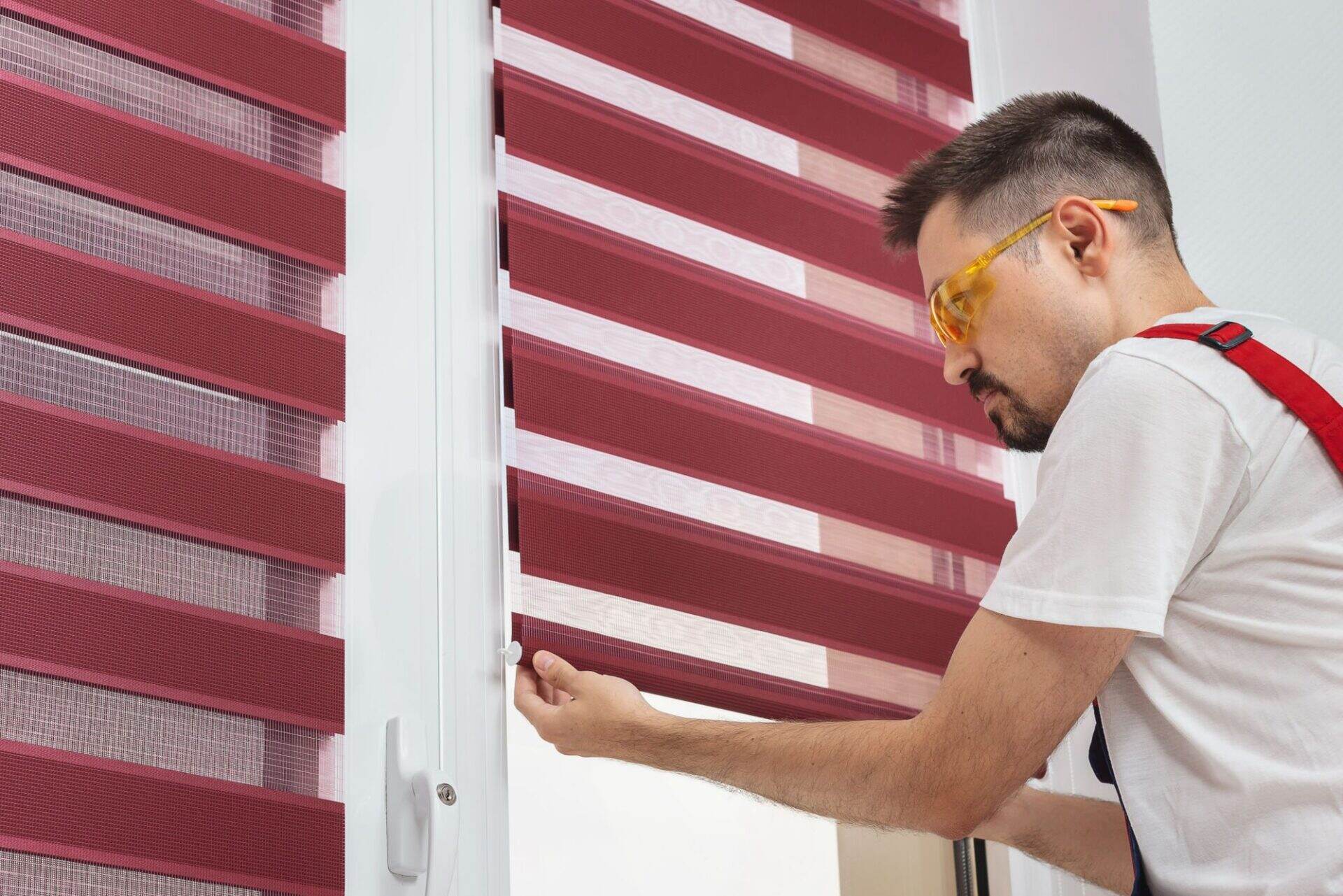

Articles
How To Keep Cats Out Of Window Blinds
Modified: August 26, 2024
Discover effective articles on how to keep cats out of window blinds. Protect your blinds and provide a safe and comfortable environment for your feline friends.
(Many of the links in this article redirect to a specific reviewed product. Your purchase of these products through affiliate links helps to generate commission for Storables.com, at no extra cost. Learn more)
Introduction:
Window blinds add style and functionality to any home, allowing sunlight to enter while maintaining privacy. However, if you’re a cat owner, you may have experienced the frustration of finding your furry friend tangled up in the blinds or using them as an impromptu playground. Not only can this be inconvenient and potentially damaging to your blinds, but it can also pose risks to your cat’s safety.
In this article, we will explore why cats are attracted to window blinds, the potential risks involved, and most importantly, how to keep them away from this tempting and potentially dangerous temptation. By implementing the preventive measures and deterrents we will discuss, you can create a cat-friendly environment that promotes both their safety and your peace of mind.
Key Takeaways:
- Understanding your cat’s attraction to window blinds and the potential risks involved is crucial for implementing effective preventive measures. By addressing their instincts and providing alternative entertainment, you can create a safe environment for your furry friend.
- Combining preventive measures, deterrents, and positive reinforcement training can effectively teach your cat to avoid window blinds. Consistency, patience, and tailoring your approach to your cat’s behavior are key to success.
Read more: How To Keep Cats Out Of Garden
Understanding why cats are attracted to window blinds:
Cats are naturally curious creatures, and their attraction to window blinds is rooted in a combination of instinct and environmental factors. Here are a few reasons why cats find window blinds enticing:
- Observation: Cats are curious by nature and love to observe the world around them. Window blinds provide an elevated perch from which they can watch birds, squirrels, and other outdoor activities. The movement and sounds from the blinds also pique their interest.
- Hunting instinct: Cats have predatory instincts, and when they see small animals or birds outside, they may instinctively want to pounce. The blinds provide a sense of privacy and allow them to feel hidden as they stalk their “prey.”
- Cosiness: Window blinds often create a cozy hiding spot for cats. The slats provide a sense of security, similar to a small, enclosed space. Cats may seek solace and relaxation by napping or lounging in the blinds.
- Climbing opportunities: Many cats are natural climbers, and window blinds offer a vertical platform for them to explore and maneuver. They may enjoy testing their agility by climbing up and down the blinds.
It’s important to understand these underlying reasons for your cat’s attraction to window blinds, as it can help in finding appropriate strategies to redirect their behavior. The next section will address the potential risks associated with cats and window blinds, and how to mitigate them.
Potential risks for cats and window blinds:
While cats may find window blinds intriguing, there are several potential risks associated with their interaction with blinds. It’s essential to be aware of these risks to ensure the safety and well-being of your furry friend. Here are some risks to consider:
- Entanglement: Cats can easily become tangled in the cords or threads of window blinds, which can lead to injury or even strangulation. This is especially dangerous if you have blinds with looped cords, as they pose a higher risk.
- Damage to blinds: Cats may scratch or chew on blinds, leading to tears, fraying, or even complete destruction of the blinds. This can be costly to repair or replace.
- Accidental falls: If the blinds are not secured properly, an adventurous cat may accidentally push or lean against them, causing them to fall. This can result in injuries, ranging from minor sprains to more severe fractures.
- Chewing hazards: Some cats have a tendency to chew on various materials. If your blinds are made of materials that are easy to chew, such as fabric or plastic, your cat may ingest small pieces, leading to digestive issues or blockages.
- Unsafe climbing: Climbing on window blinds can be dangerous, especially if the blinds are not sturdy or mounted securely. Cats may lose their balance, fall, or cause the blinds to collapse, potentially injuring themselves or damaging surrounding objects.
Given these risks, it’s crucial to take proactive measures to prevent your cat from interacting with window blinds. The next section will provide helpful preventive strategies to keep your cat away from this potential hazard.
Preventive measures to keep cats out of window blinds:
Preventing your cat from accessing window blinds is key to ensuring their safety and maintaining the integrity of your blinds. Here are some effective preventive measures to help keep your cat away from window blinds:
- Shorten the cords: One of the most crucial steps is to address the cord issue. Keep the cords of your blinds short and out of your cat’s reach. You can use cord cleats or cord winders to secure the excess length and prevent your cat from getting tangled.
- Install cordless blinds: Consider replacing your current blinds with cordless options. Cordless blinds eliminate the risk of entanglement and provide a safer alternative for your cat.
- Secure the blinds: Ensure that your blinds are properly installed and secured to prevent them from falling or being easily pulled down by your cat’s weight or movements. Use sturdy brackets and screws to secure them in place.
- Close the blinds: When you’re not around to supervise, it’s a good idea to close the blinds completely. This eliminates the temptation for your cat to climb or play with them.
- Use window film: Another option is to apply window film or frosted adhesive to the bottom portion of your windows. This obstructs your cat’s view and reduces their interest in the blinds.
- Provide alternative perches: Cats love perching by the window to observe the outside world. Create alternative elevated areas near the window, such as cat trees or shelves, where your cat can comfortably observe without the need to interact with the blinds.
- Use double-sided tape: Cats dislike sticky surfaces. Apply double-sided tape on the blinds or around the windowsill to deter your cat from approaching them.
- Offer distractions: Provide interactive toys, scratching posts, and puzzle feeders to keep your cat engaged and entertained. This can redirect their attention from the blinds and discourage them from seeking entertainment in that area.
By implementing these preventive measures, you can significantly reduce the likelihood of your cat accessing and engaging with window blinds. However, some cats may still not be deterred by these methods. In such cases, using deterrents can be an effective additional strategy, as discussed in the next section.
Install motion-activated deterrents or double-sided tape on the blinds to discourage cats from climbing or playing with them. Keep the blinds raised when not in use to minimize temptation.
Using deterrents to discourage cats from approaching window blinds:
If your cat continues to show a strong interest in window blinds despite the preventive measures taken, using deterrents can help discourage them from approaching or interacting with the blinds. Here are some effective deterrents to consider:
- Bitter sprays or deterrent tapes: Cats dislike certain scents and tastes. Spraying bitter-tasting deterrents on the blinds or using adhesive deterrent tapes can discourage your cat from approaching or chewing on them.
- Motion-activated deterrents: Install motion-activated devices near the blinds that emit a loud noise, a burst of air, or a gentle spray of water when your cat approaches. This startles them and teaches them to associate the blinds with an unpleasant experience.
- Ultrasonic devices: Ultrasonic devices emit high-frequency sounds that are unpleasant to cats but inaudible to humans. Place these devices near the windows or blinds to discourage your cat from approaching.
- Aluminum foil or plastic wrap: Cats dislike the texture and sound of crinkly materials. Cover the blinds with aluminum foil or plastic wrap to create an unappealing surface that deters your cat from approaching.
- Redirect their attention: Engage your cat in interactive play sessions or offer treats when they show an interest in the blinds. This redirects their attention to more positive and rewarding activities, minimizing their focus on the blinds.
Remember, each cat is unique, and what works for one may not work for another. It’s essential to experiment with different deterrents and observe your cat’s response to find the most effective solution for keeping them away from the blinds.
In addition to using deterrents, providing alternative sources of entertainment for your cat can help redirect their energy and curiosity away from the blinds. Let’s explore this further in the next section.
Read more: How To Keep Your Cat Out Of The Fireplace
Providing alternative sources of entertainment for cats:
Keeping your cat entertained and mentally stimulated is crucial in preventing them from seeking amusement from window blinds. By providing alternative sources of entertainment, you can redirect their attention and minimize their interest in the blinds. Here are some ideas:
- Interactive toys: Invest in a variety of interactive toys that mimic prey animals, such as feather wands, puzzle toys, or treat-dispensing toys. These toys engage your cat’s hunting instincts and keep them occupied for hours.
- Scratching posts: Cats have a natural instinct to scratch, and providing them with appropriate scratching posts or boards can help redirect their attention from the blinds. Choose sturdy and tall scratching posts that cater to their stretching and scratching needs.
- Window perches: Install comfortable window perches that allow your cat to observe the outside world without having to interact with the blinds. Cats love lounging in sunny spots, so providing them with a cozy perch near the window can be a great alternative.
- Cat trees or shelves: Cats love climbing and exploring their surroundings. Install a cat tree or shelves near the window to create vertical spaces for your cat to climb, jump, and play. This provides them with a designated area for physical activity, away from the blinds.
- Rotate toys: Keep your cat’s toy collection fresh by rotating toys regularly. This prevents them from losing interest and ensures they always have something new and exciting to play with.
- Playtime and interaction: Dedicate daily playtime sessions with your cat to engage them in interactive games. Use laser pointers, feather toys, or engage in gentle wrestling to keep them mentally and physically stimulated.
- Window bird feeders: Install bird feeders outside your window to attract birds. Watching birds can provide hours of entertainment for your cat and distract them from the blinds.
By providing alternative sources of entertainment, you create an environment that is mentally stimulating and engaging for your cat, reducing their desire to explore and engage with the blinds.
However, it’s important to note that even with these alternative options, some cats may still be drawn to the blinds out of habit or curiosity. In such cases, training your cat to avoid the blinds can be a beneficial step, which we will discuss in the next section.
Training your cat to avoid window blinds:
Training your cat to stay away from window blinds can be a gradual process that requires patience and consistency. Here are some steps to help train your cat to avoid the blinds:
- Positive reinforcement: Use treats, praise, and rewards to reinforce desired behavior. Whenever your cat avoids the blinds or engages in alternative activities, offer them treats and verbal encouragement to create a positive association.
- Redirect their attention: When you catch your cat approaching the blinds, gently redirect their attention to a preferred alternative such as a toy or scratching post. Encourage them to engage in the alternative activity and reward them for doing so.
- Use verbal cues: Teach your cat a specific verbal cue or command, such as “leave it” or “no blinds,” to indicate that they should stay away from the blinds. Consistently use the cue whenever they approach the blinds and reward them when they respond appropriately.
- Provide visual barriers: Use temporary visual barriers, such as cardboard or lightweight screens, to block access to the blinds. This physically prevents your cat from reaching the blinds, helping to break the habit of interacting with them.
- Simulate undesirable experiences: Use harmless techniques, like shaking a can filled with coins or using a loud noise maker, when your cat attempts to approach or play with the blinds. This discourages them from engaging with the blinds by creating an unpleasant experience.
- Consistency and repetition: Training takes time and consistency. Be patient and continue to reinforce the desired behaviors consistently. Consistency is key to the success of training your cat to avoid the window blinds.
Remember, each cat is unique, and training results may vary. It’s important to tailor your approach to your cat’s temperament and adjust training techniques accordingly. Consulting with a professional animal behaviorist can also provide valuable guidance and support in training your cat to avoid the blinds.
By combining training techniques, deterrents, and providing alternative sources of entertainment, you can effectively teach your cat to stay away from window blinds and create a safe and harmonious living environment for both you and your furry friend.
Conclusion:
Window blinds can be a tempting and potentially dangerous object of interest for cats. Understanding why cats are attracted to them and the risks involved is the first step in keeping your feline friend safe. By implementing preventive measures, using deterrents, providing alternative sources of entertainment, and training your cat, you can effectively keep them away from window blinds and create a cat-friendly environment.
Shortening or eliminating cords, securing the blinds, and closing them when not in use are essential preventive measures that help minimize the risks. Installing cordless blinds or applying window film can further reduce your cat’s interest in the blinds. Creating alternative perches, providing interactive toys and scratching posts, and engaging in play sessions help redirect your cat’s attention away from the blinds.
Using deterrents such as bitter sprays, motion-activated devices, or double-sided tape can discourage your cat from approaching the blinds. Training your cat with positive reinforcement and redirecting their attention can also be effective in teaching them to stay away from the blinds. Consistency, patience, and repetition are key when training your cat to avoid the blinds.
Remember, every cat is unique, and what may work for one cat may not work for another. It’s important to tailor your approach to your cat’s behavior and temperament. Consulting with an animal behaviorist can provide valuable insight and guidance if needed.
By implementing these strategies, you can create a safe and harmonious home environment where your cat can thrive without the risks associated with window blinds. Focus on creating a space that caters to their natural instincts, provides enrichment, and keeps them entertained. With proper care and attention, you and your cat can enjoy a peaceful coexistence without the worry of tangled blinds or potential hazards.
Frequently Asked Questions about How To Keep Cats Out Of Window Blinds
Was this page helpful?
At Storables.com, we guarantee accurate and reliable information. Our content, validated by Expert Board Contributors, is crafted following stringent Editorial Policies. We're committed to providing you with well-researched, expert-backed insights for all your informational needs.















0 thoughts on “How To Keep Cats Out Of Window Blinds”